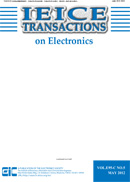
- |<
- <
- 1
- >
- >|
-
Yoshiki KAYANO2021Volume E104.CIssue 12 Pages 672
Published: December 01, 2021
Released on J-STAGE: December 01, 2021
JOURNAL FREE ACCESSDownload PDF (54K) -
Ryosuke SANO, Junya SEKIKAWAArticle type: PAPER
2021Volume E104.CIssue 12 Pages 673-680
Published: December 01, 2021
Released on J-STAGE: December 01, 2021
Advance online publication: June 09, 2021JOURNAL RESTRICTED ACCESSObserved results of arc discharges generated between the brush and commutator are reported. The motion of the arc discharges was observed by a high-speed camera. The brush and commutator were installed to an experimental device that simulated the rotational motion of a real DC motor. The aim of this paper is to investigate the occurring position, dimensions, and moving characteristics of the arc discharges by means of high-speed imaging. Time evolutions of the arc voltage and current were measured, simultaneously. The arc discharges were generated when an inductive circuit was interrupted. Circuit current before interruption was 4A. The metal graphite or graphite brush and a copper commutator were used. Following results were obtained. The arc discharge was dragged on the brush surface and the arc discharge was sticking to the side surface of the commutator. The positions of the arc spots were on the end of the commutator and the center of the brush in rotational direction. The dimensions of the arc discharge were about 0.2 mm in length and about 0.3 mm in width. The averaged arc voltage during arc duration became higher and the light emission from the arc discharge became brighter, as the copper content of the cathode decreased.
View full abstractDownload PDF (2496K)
-
Sota MATSUMOTO, Ryosuke SUGA, Kiyomichi ARAKI, Osamu HASHIMOTOArticle type: BRIEF PAPER
Subject area: Electromagnetic Theory
2021Volume E104.CIssue 12 Pages 681-684
Published: December 01, 2021
Released on J-STAGE: December 01, 2021
Advance online publication: June 07, 2021JOURNAL RESTRICTED ACCESSIn this paper, an ultra-thin wave absorber using a resistive patch array closely-placed in front of a back-metal is designed. The positively large susceptance is required for the patch array to cancel out the negatively large input susceptance of the short-circuited ultra-thin spacer behind the array. It is found that the array needs the gap of 1mm, sheet resistance of less than 20Ω/sq. and patch width of more than 15mm to obtain the zero input susceptance of the absorber with the 1/30 wavelength spacer. Moreover, these parameters were designed considering the electromagnetic coupling between the array and back-metal, and the square patch array absorbers with the thickness from 1/30 to 1/150 wavelength were designed.
View full abstractDownload PDF (497K) -
Koichi MAEZAWA, Tatsuo ITO, Masayuki MORIArticle type: BRIEF PAPER
Subject area: Semiconductor Materials and Devices
2021Volume E104.CIssue 12 Pages 685-688
Published: December 01, 2021
Released on J-STAGE: December 01, 2021
Advance online publication: June 07, 2021JOURNAL RESTRICTED ACCESSA hard-type oscillator is defined as an oscillator having stable fixed points within a stable limit cycle. For resonant tunneling diode (RTD) oscillators, using hard-type configuration has a significant advantage that it can suppress spurious oscillations in a bias line. We have fabricated hard-type oscillators using an InGaAs-based RTD, and demonstrated a proper operation. Furthermore, the oscillating properties have been compared with a soft-type oscillator having a same parameters. It has been demonstrated that the same level of the phase noise can be obtained with a much smaller power consumption of approximately 1/20.
View full abstractDownload PDF (751K)
- |<
- <
- 1
- >
- >|